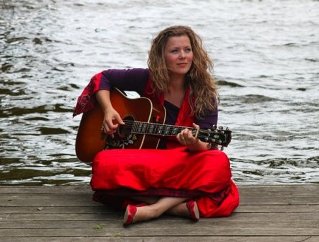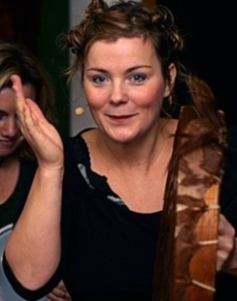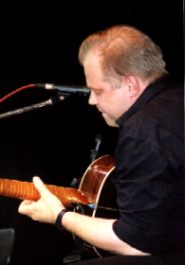Deutsch
På Dansk
FolkWorld Issue 40 11/2009; Article by Morten Alfred Høirup (Translation by Rod Sinclair)
|
Deutsch |
På Dansk |
Freja's Songs
Stine Michel & The Love Goddess' Songs
In the past decade, Danish singer Stine Michel (born in 1973) has recorded a handful of albums, won a Danish Music Award and given hundreds of concerts for children and adults throughout Denmark. Stine Michel writes the songs, both words and music, and her story-telling - both fairy tales and more everyday epics -, her dancing, and her musicianship always move and engage her audiences. Stine is supported by a team of accomplished musicians, who arrange and accompany her concerts on Swedish key harp, acoustic guitar, bass and percussion. The next couple of years will see Stine Michel tour Denmark and the rest of Scandinavia with Freja's Songs, a cycle of songs and tales about the Nordic love goddess Freja, set in a modern context. But it all started many years ago when a very young girl rode out on her chestnut horse.
The Girl on the Chestnut Horse
 Stine Michel @ FolkWorld: FW #30 |
Stine's father, a musician and music teacher, would often play guitar for his little daughter at bedtime. His musical bent produced many children's songs, too. As a child, Stine attended choir and folk-dancing rallies, and when her father became principal of a music school, Stine met the many-facetted world of music in the form of theory, aural training, but also big bands and other practical aspects of music.
”I lived on a farm with my family, my old granny and lots of foster children, and when things got too hectic and noisy, I would saddle my little chestnut horse and ride out in the woods, along rivers and paths in the marshes and moors where we lived. I spent a lot of time out there when I was young, listening to birdsong instead of the fusion music my father sometimes used to listen to. Like anybody else, I needed breathing space. I was beyond reach when I was out on my horse. I could be away for 3 or 4 hours at a time, for this was before mobile phones and all that. I never had to account for the time I was out in the woods, and that was immensely important for my imagination. It was like having the key to a creative room, seeing a nest being built there, a plumtree in bloom there. I would often lie under a tree and sing while my horse rested and grazed nearby. My life in the woods and moors has inspired my records for children and grown-ups since.
When Stine leaves home, she begins to find her own musical voice. This leads her to Berklee in Boston, USA, where she meets cultures from the whole world, develops various musical abilities and realizes that music is something you can compose yourself. Back home, Stine Michel attends the Institute of Musical Science, where, again, she meets people with many different musical backgrounds, then applies for the Music and Movement line at the Rhythmic Music Conservatory. Here she works intensively with jazz, gospel, Cuban and Brasilian music and dance. Study trips to Cuba, among other places, show her how deeply integrated music, song, dance and story-telling are in local cultures.
Song, Dance & Story
”In my fourth year at the Conservatory, one of my teachers was the Swedish singer, Marie Bergman. I told her of my search for my own musical identity and sound, my need to find the core of our Danish cultural identity. Marie asked if I knew about the West Jutland Folk High School's course in ritual dance and story-telling. I took the course and was completely bowled over. This was Europe's soul, a melting pot of music, dance and story, involving people from all over the North. I was mesmerised, there was so much I did not understand, but it was all borne by a mythical language that reverberated deep in me. I knew I had found the real key, and the door was open to my way forward. I did the two-year ritual dance and story course at the West Jutland Folk High School simultaneously with my final years at the Conservatory. It was in West Jutland it happened: that was where the spark was lit.”
 After this epiphany, Stine Michel sets out to find her own roots, through conversations with her old paternal grandmother, who has lived with the family since Stine was little. She investigates her family history, a dramatic affair involving a German Jewish grandfather who fled to Sweden, and this forms the basis of her apprentice piece, concluding her course in ritual dance and story.
After this epiphany, Stine Michel sets out to find her own roots, through conversations with her old paternal grandmother, who has lived with the family since Stine was little. She investigates her family history, a dramatic affair involving a German Jewish grandfather who fled to Sweden, and this forms the basis of her apprentice piece, concluding her course in ritual dance and story.
Freja's Songs
The course at the West Jutland Folk High School, and the awareness that she can use her own history and background, were key points in Stine Michel's musical development. This unique experience, enabling her to unite dance, story and song in one form of expression based on Danish culture and tradition, are what she uses to this day to tell, for instance, the story of the Nordic love goddess, Freja, and her life in the Danish capital, Copenhagen.
”In the cycle of songs I call Freja's Songs, I imagine that our Nordic love goddess, Freja, visits the Earth – as gods occasionally do – and she settles in Vanløse, here in Copenhagen. Here she opens a shop: Freja's Temptations, and she is so damned fertile that she has one child after another with different men, which of course offends many people. But she is still a goddess, an example for men and women, though she falls out with some and is an expert manipulator - for better or for worse - as we know from our Nordic mythology. When a woman is seductive, she is attractive but also dangerous. Working with Freja's songs, I have drawn on my own experience of love, births, a long period living with a man, loss of friends, and not least the erotic and sexual aspects, which are very important in Freja's Songs, since she is, after all, our Nordic love goddess. I am at an age now when I have been in a relationship for several years, I have children, and love has played all its roles in my life, bringing both sorrow, infatuation, deep love, and love for my children. Love means more and more to me in my life. Suddenly, one day, there was Freja, calling to me, and I thought, ’This is an opportunity I must not let slip!”

Morten Alfred Høirup (*1961) is a Danish musician, composer and music journalist. He has been playing the guitar and singing in the Danish duo Haugaard & Høirup, and is currently working freelance for Danish Roots. www.mortenalfred.dk, www.danishroots.eu |
Photo Credits:
(1)-(2) Stine Michel (from website);
(3) Morten Alfred Høirup (by The Mollis).
|
To the German FolkWorld |
© The Mollis - Editors of FolkWorld; Published 11/2009
All material published in FolkWorld is © The Author via FolkWorld. Storage for private use is allowed and welcome. Reviews and extracts of up to 200 words may be freely quoted and reproduced, if source and author are acknowledged. For any other reproduction please ask the Editors for permission. Although any external links from FolkWorld are chosen with greatest care, FolkWorld and its editors do not take any responsibility for the content of the linked external websites.
